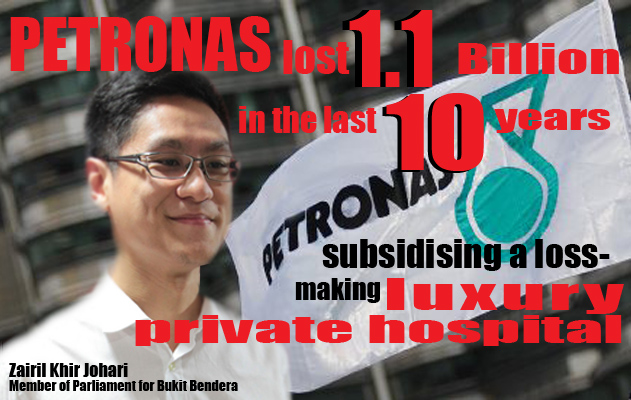by Zairil Khir Johari
 The recent 2012 Auditor-General’s Report has once again raised a storm over the Federal Government’s track record in financial management and expenditure. According to Serdang MP Dr Ong Kian Ming, up to RM6.5 billion may have been wasted over 64 cases identified by the report.
The recent 2012 Auditor-General’s Report has once again raised a storm over the Federal Government’s track record in financial management and expenditure. According to Serdang MP Dr Ong Kian Ming, up to RM6.5 billion may have been wasted over 64 cases identified by the report.
However, there is one major Government-Linked Company that does not get reviewed by the Auditor-General, and that is our national oil company, Petronas. Formed by an Act of Parliament in 1974, Petronas is the custodian of our nation’s entire oil and gas resources, and remains until today Malaysia’s one and only Fortune 500 company.
Petronas is also the Federal Government’s financial backer, providing 40 per cent of the Federal Budget through dividends, oil royalty and taxes, but excluding gas subsidies, which are additional contributions.
By law, specifically Section 3(2) of the Petroleum Development Act, Petronas is answerable solely to the Prime Minister. Even Members of Parliament have no access to its financial records besides a simple annual report that is published for public consumption.
More than a billion in losses
Besides oil and gas, Petronas has in recent times ventured out of its core business in an attempt to diversify its portfolio. As a result, Petronas is now heavily invested into properties as well as the healthcare sector through Prince Court Medical Centre, a luxury private hospital situated in the heart of KL city.
However, at a cost of RM544 million to build, the investment in Prince Court Medical Centre has not been able to reap any profit. In fact, according to its annual report, the private hospital has been suffering huge losses every year for 10 years in a row, particularly in the last five years since its operations started.
In 2008, Prince Court lost a total of RM111 million. This figure nearly doubled to RM192 million in 2009 before haemorrhaging a further RM450 million in 2010. By year ending 31 December 2011, the accumulated losses stood at an incredible RM1.08 billion, as shown in the table below.
Income Statement for Prince Court Medical Centre (2002-2011)
| Year (31 March) |
2002-2007 |
2008 |
2009 |
2010 |
2011 |
2011 (31 Dec) |
| Revenue |
– |
3,236,375 |
32,780,002 |
49,290,328 |
74,731,365 |
67,190,166 |
| Gross Profit |
– |
56,029 |
21,955,887 |
40,077,219 |
36,766,570 |
|
| Net Profit |
– |
– |
– |
– |
||
| Loss for the Year |
55,158,456 |
111,221,071 |
192,794,384 |
450,578,215 |
166,455,753 |
138,106,830 |
|
Total losses |
1,114,314,709 |
|||||
|
Total losses after reconciling effects of (1) reversal of fair value upon equity conversion in 2009 and (2) adopting FRS139 for year ended 31 March 2009 |
1,082,949,412 |
|||||
Prince Court’s financial performance is in stark contrast to other private hospitals. For example, according to IHH Healthcare’s 2012 financial report, Parkway Pantai, which owns a chain of hospitals in Malaysia and Singapore, recorded RM4.75 billion in revenue for 2012, out of which RM818 million was declared as profit.
Should the public subsidise a loss-making luxury private hospital?
According to a Parliamentary reply I received from Minister in the Prime Minister’s Department Senator Dato’ Sri Abdul Wahid Omar, the Government considers Prince Court’s business model to be sound, and that heavy investments are needed due to the superior state-of-the-art technology used.
Wahid further added that the hospital has been able to achieve 23 per cent growth in the first quarter of 2013 and was recently named the “World’s Best Hospital” in a medical tourism ranking by Medical Travel Quality Alliance.
Even if it is indeed the “world’s best hospital,” it still remains a question whether Prince Court is able to eventually turn a profit, and if not, then why is the public effectively subsidising a loss-making luxury private hospital.
The bigger question is: should Petronas even be engaged in non-core activities such as healthcare and property, being as its mandate and expertise is in the field of oil and gas? Other oil companies typically only invest in oil and gas-related industries and do not stray away from their core competency.
The huge losses amounting to RM1.1 billion suffered by Prince Court clearly proves that Petronas should not be involved in non-core businesses. Meanwhile, this episode also signals an urgent need for greater oversight in Petronas’s financial matters, especially considering the importance of the national oil company to our country’s coffers.



